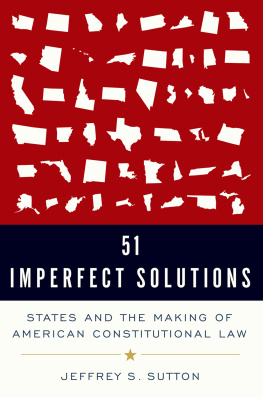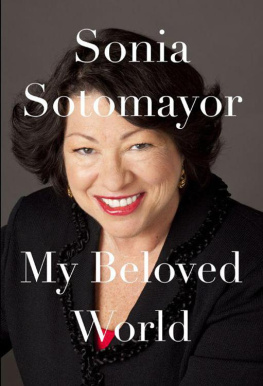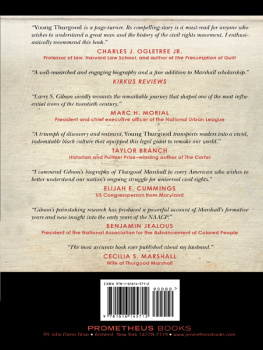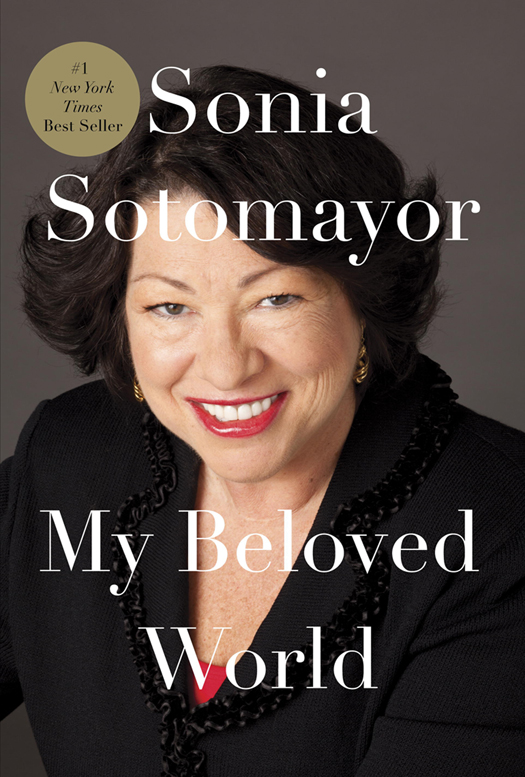THIS IS A BORZOI BOOK
PUBLISHED BY ALFRED A. KNOPF
Copyright 2013 by Sonia Sotomayor
All rights reserved. Published in the United States by Alfred A. Knopf, a division of Random House, Inc., New York, and in Canada by Random House of Canada Limited, Toronto.
www.aaknopf.com
Knopf, Borzoi Books, and the colophon are registered trademarks of Random House, Inc.
All photos are from the authors personal collection, except for the last photo in the photo insert, which is by Steve Petteway, courtesy of the Supreme Court of the United States.
Library of Congress Cataloging-in-Publication Data
Sotomayor, Sonia, 1954.
My beloved world / Sonia Sotomayor.
p. cm.
eISBN: 978-0-307-96216-4
1. Sotomayor, Sonia, 1954 2. Hispanic American judgesBiography. 3. Hispanic American womenBiography. 4. Women judgesBiography. 5. JudgesUnited StatesBiography. 6. United States. Supreme CourtOfficials and employeesBiography. I. Title.
KF8745.S67A3 2013
347.732634092dc23
[B]
2012031797
Jacket photograph by Elena Seibert
Jacket design by Peter Mendelsund
v3.1_r2
Contents
Perdonadle al desterrado
ese dulce frenes:
vuelvo a mi mundo adorado,
y yo estoy enamorado
de la tierra en que nac.
Forgive the exile
this sweet frenzy:
I return to my beloved world,
in love with the land where I was born.
from To Puerto Rico (I Return),
by Jos Gautier Bentez
Preface
Since my appointment to the Supreme Court, I have spoken to a wide variety of groups in different settings, answering all sorts of questions. Many people, predictably, have asked about the law, the Court, and my journey as a judge. But many more, to my surprise, have asked about my personal story, curious to know how I had managed and been shaped by various circumstances in my early life, especially the ones that didnt naturally promise success.
At a conference on juvenile diabetes, a six-year-old asked plaintively if living with the disease ever gets easier. Elsewhere, a child who had recently lost a parent asked how I had coped with losing my father at an early age. Minority students have asked what it is like to live between two worlds: How do I stay connected to my community? Have I ever experienced discrimination? Many young lawyers, men as well as women, have asked how I balance my personal life with the demands of career. Most perplexing of all was the question that inspired this book: How much did I owe to having had a happy childhood? I struggled with that one; until this book I have not spoken publicly about some of my darker experiences growing up, and I would not have considered myself unqualifiedly happy as a child. Ultimately, though, I realized I did have sources of deep happiness, and these bred in me an optimism that proved stronger than any adversity.
Underlying all these questions was a sense that my lifes story touches people because it resonates with their own circumstances. The challenges I have facedamong them material poverty, chronic illness, and being raised by a single motherare not uncommon, but neither have they kept me from uncommon achievements. For many it is a source of hope to see someone realize her dreams while bearing such burdens. Having caught peoples attention in this way, Ive thought long and hard about what lessons my life might hold for others, young people especially. How is it that adversity has spurred me on instead of knocking me down? What are the sources of my own hope and optimism? Most essentially, my purpose in writing is to make my hopeful example accessible. People who live in difficult circumstances need to know that happy endings are possible.
A student recently posed another question that gave me pause: Given that there are only nine Supreme Court Justices, each with life tenure, can anyone realistically aspire to such a goal? How do we hold on to dreams that, statistically, are almost impossible? As I tell in these pages, the dream I first followed was to become a judge, which itself seemed far-fetched until it actually happened. The idea of my becoming a Supreme Court Justicewhich, indeed, as a goal would inevitably elude the vast majority of aspirantsnever occurred to me except as the remotest of fantasies. But experience has taught me that you cannot value dreams according to the odds of their coming true. Their real value is in stirring within us the will to aspire. That will, wherever it finally leads, does at least move you forward. And after a time you may recognize that the proper measure of success is not how much youve closed the distance to some far-off goal but the quality of what youve done today.
I have ventured to write more intimately about my personal life than is customary for a member of the Supreme Court, and with that candor comes a measure of vulnerability. I will be judged as a human being by what readers find here. There are hazards to openness, but they seem minor compared with the possibility that some readers may find comfort, perhaps even inspiration, from a close examination of how an ordinary person, with strengths and weaknesses like anyone else, has managed an extraordinary journey.
My law clerks will no doubt be aghast to see how often Ive broken my own very strict rules about formal writing, which include injunctions against the use of contractions and split infinitives. Every rule, however, is bound by context, and a personal memoir requires a different style than a legal opinion.
Neither is a memoir the same as a biography, which aims for the most objective, factual account of a life. A memoir, as I understand it, makes no pretense of denying its subjectivity. Its matter is one persons memory, and memory by nature is selective and colored by emotion. Others who participated in the events I describe will no doubt remember some details differently, though I hope we would agree on the essential truths. I have taken no liberties with the past as I remember it, used no fictional devices beyond reconstructing conversations from memory. I have not blended characters, or bent chronology to convenience. And yet I have tried to tell a good story. If particular friends or family members find themselves not mentioned, or are disappointed to see their roles rendered as less prominent than they might have expected, I hope they will understand that the needs of a clear and focused telling must outweigh even an abundance of feeling.
Some readers may be disappointed that I have chosen to end this story twenty years ago, when I first became a judge. Ive made this choice because of the personal nature of what I wish to tell. For though I believe my personal growth has continued since that time, it was by then that the person I remain was essentially formed. On the other hand, I have no such perspective or sense of completion regarding my judicial career. Each stage of itfirst on the district court, then on the court of appeals, and now on the Supreme Courthas been unique; and I cant say with any certainty how any part will inform what I may yet accomplish as a Justice. In the meanwhile, it seems inappropriate to reflect on a course still taking shape, let alone on the political drama attending my nomination to the High Court, however curious some may be about that.
A final, more private, motive for writing this book bears mention. This new phase of my career has brought with it a profoundly disconcerting shift in my life. The experience of living in the public eye was impossible to anticipate fully and has, at times, been overwhelming. The psychological hazards of such a life are notorious, and it seems wise to pause and reflect on the path that has brought me to this juncture and to count the blessings that have made me who I am, taking care not to lose sight of them, or of my best self, as I move forward.







